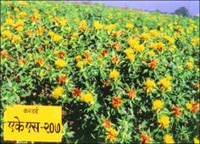| About Project |  |
||
| Objectives | |||
| Research Activities and Achievements | |||
| Recommendations | |||
| Scientists | |||
| Contact Information |
About Project
All India Coordinated Research Project on safflower is functioning at Dr. PDKV, Akola from the year 2001 and since then region specific research on safflower got impetus. Safflower (Carthamus tinctorius L.), commonly known as Kardi is one of the important rabi oilseed crops of the state. Despite of increase in the productivity of this crop and its inherent hardy and drought tolerant nature and quality oil, it is observed that there is decline in area.
Objectives
Breeding Objectives
- To develop high yielding variety with high seed oil content (35-38%).
- To develop high yielding early maturing variety (<120 days) for medium texture soil.
- To incorporate aphid tolerance in agronomically acceptable genotypes.
- To develop variety tolerant to Alternaria leaf blight, wilt and root rot.
Objective for Agronomy
- To assess the response of new safflower entries to the chemical fertilizer
- To study the optimum spacing required for new safflower entries
- To enhance the productivity of safflower, to integrate different sources of plant nutrients for safflower based cropping system, to economize inorganic fertilizer use and to sustain productivity.
Research Activities / Achievements
Crop Improvement: Release of varieties/Hybrids:
 |
 |
 |
||
| AKS 207 | PKV PINK | PKV PINK FLOWER |
Recommendations
Recommendations passed on to the extension agencies
A. Crop Production
- Optimum sowing time for safflower under rainfed is last week of September to first week of October for higher yields and minimising attack of aphids. Under irrigated condition, sowing can be extended upto last week of October.
- A spacing at 45 x 20 cm to 30 cm with plant population ranging from seventy five thousand to one lakh gives higher yields in safflower.
- For higher yield of irrigated safflower 40 kg N+40kg P2O5/ha is recommended. 50% N and 100% P2O5 at the time of sowing and remaining 50% N after 30 days of the sowing have to be given.
- Three to five irrigations should be given to safflower in medium to lighter type of soils for higher yields.
- Safflower should be irrigated twice i.e. at 35 and 55 days after sowing in medium to heavy soils for higher yields. If only one irrigation is available, it should be given at 55 days after sowing.
- Intercropping of safflower with gram or linseed in 6:3 or 3:3 row proportion (30cm) and two rows of safflower paired (30/60 cm) plus one row of gram or linseed is profitable.
- In favourable conditions, application of fertilizer @ 25:25:0 NPK kg/ha is recommended.
- To save 25% P2O5 (18.75kg/ P2O5/ha) it is recommended to treat seed with PSB @ 200 g/10kg seed.
- For getting higher seed yield and monetory return seed of safflower should be treated with Azotobactor and Azospirilum 20 g/kg seed along with 12.5 kg N/ha are recommended.
- In Vidarbha region of Maharashtra, application of cycocel @ 500 ppm either at flower initiation or at 50% flowering could increase the seed yield of safflower by 15 % under moisture stress conditions.
- In Vidarbha region of Maharashtra , apply 30 kg S/ha through single super phosphate to increase seed yield and returns of safflower under rainfed conditions.
-
In Vertisols (Deep black soil), for maximum yield and highest monitory return in irrigated condition, sowing of safflower during 40th MW (1st week of October) or as late as 44th MW (1st week of November) is recommended. Also, two irrigations, first during vegetative stage (30 DAS) and second at grain development stage (80 DAS) is recommended.
B. Plant Protection (Plant Pathology)
- For controlling Alternaria Leaf Spot, seed treatment with Thirum or Captan 3g/kg seed is rcommended and in field condition spraying with Dithane M-45, 25g in 10 litre of water is recommended.
- For controlling root rot and wilt, seed treatment with thirum or captan @ 3g/kg seed alongwith seed treatment of biological fungicide Tricoderma 4g/kg seed is recommended.
C. Plant Protection (Entomology)
- Early sowing (i.e. during 25th September to 10th October) of safflower is recommended to escape from aphid infestation.
- It is recommended to adopt plant protection measures against safflower aphid when economic threshold level of aphid colonies on 30% plants is reached.
- For management of safflower aphids spraying of Fenthion 50 EC (10ml) or Quinalphos 25 EC (20ml) or Thiometon 25 EC (12ml), or Dimethoate 30 EC (10ml), or Acephate 75% WSP 4gm or Malathion 50 EC (20ml) or Carbaryl 50% WSP 20g in 10 lit of water or dusting of Quinalphos 1.5 % dust or Methyl Parathion 2% dust or Phosalone 4 % dust @ 20kg/ha is recommended.
- For effective management of Gujhia weevil, application of Phorate 10 G @ 10 Kg/ha at sowing + foliar spray of chlorphriphos 20 EC @ 25 ml OR Lymbda chalothrin 2.5 EC @ 10 ml/10 ltr of water at 10 days after emergence and need based second spraying at 10 days after first application is recommended
Contact Information
Senior Research Scientist (Oilseeds)
Oilseed Research Unit (Oilseeds)
Dr. PDKV, Akola- 444104 (M. S.)
Phone (O): 0724 2258467
Mobile: +9198-50314086
E-mail : srsoilseedspdkv@rediffmail.com
